Top 15 Strategies for Boosting eCommerce ROI in 2025 [+Examples]

Every business owner wants to increase profitability.
After all, that’s how you sustain the business, right? And that’s why you want to ensure your marketing campaigns are profitable.
But how do you measure the profitability of your marketing campaigns? ROI, i.e., “return on investment”, is one of the methods to measure the profitability of your marketing campaigns.
So, in this blog post, we’re going to share all the basics and strategies for boosting eCommerce ROI. We’ll also share tips, tools, and examples to help you skyrocket the ROI of your eCommerce or Shopify store.
Let’s get started!
The Basics of eCommerce ROI:
What is eCommerce ROI?
The eCommerce ROI is the method of calculating the profitability or potential of an investment made on marketing or ads. It basically tells you how much financial gain or loss you’ve made against the capital invested in marketing or ads.
By the way, we intentioned mentioned the word “potential of an investment” as well. The reason is — one of the methods of measuring ROI (The CLV-based method) also considers how much return can be earned on an investment in the future as well. But we’ll cover that in the next section.
You can calculate an overall ROI covering all your investments OR calculate the ROI based on the specific channel/platform/strategy where you’re investing.
How to Calculate the eCommerce ROI?
There are two different ways to know how to measure ecommerce ROI.
-
Method #1: The Net-Profit-Based Formula
This is a simple and easier formula for calculating ROI:
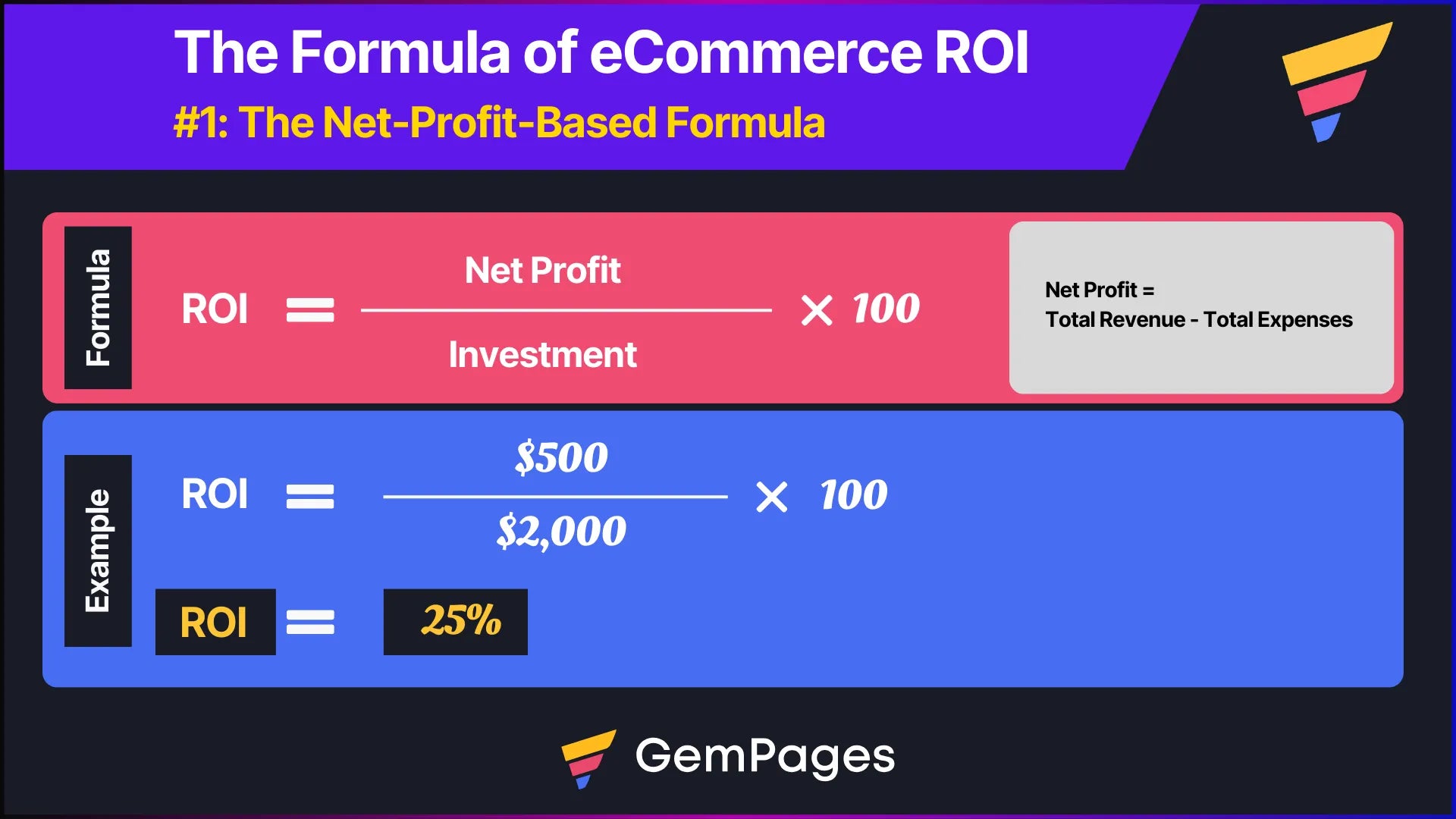
-
Method #2: The CLV-Based Formula
This is more of an advanced formula. This one considers the Customer Lifetime Value (CLV or CLTV) instead of the net profit as the key factor.
The idea is that the initial net profit earned from the customers might not give you a real picture as you should also consider their future/repeat purchases.
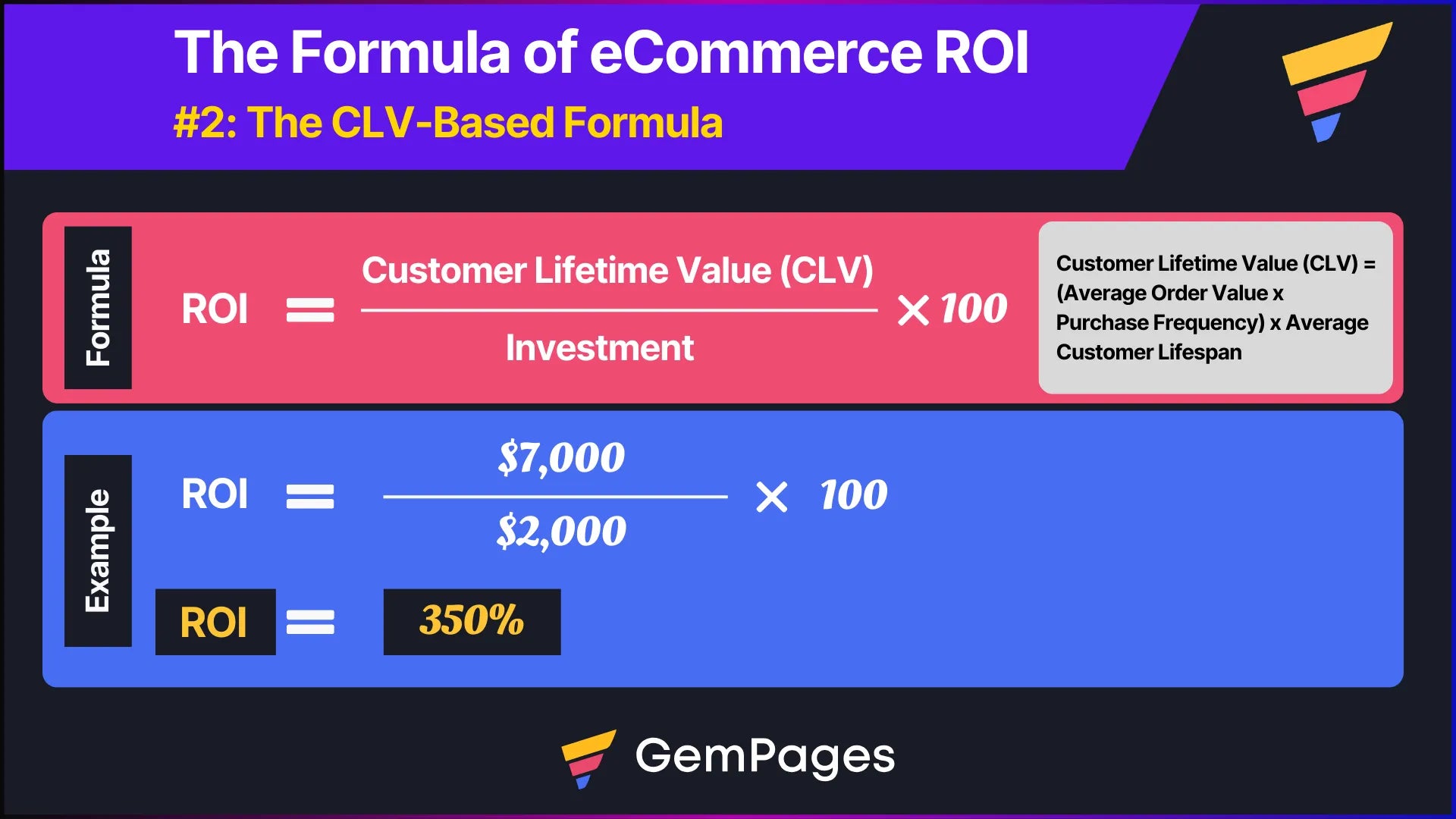
Why Measuring the eCommerce ROI is Important?
Measuring the ROI helps you rank investment alternatives and figure out where you should invest more. This way, you can reduce the investment on the marketing channels that are not generating good profit and double down on the ones that are giving the maximum ROI.
For example, let’s you’re investing in SEO, Facebook ads, and influencer marketing. Now you can calculate your overall ROI by considering all these 3 strategies where you’re investing and find out how much return you’re making overall.
AND — you can go by each strategy individually as well.
For example, let’s assume your blog is giving 40% ROI, Facebook ads are giving 25% ROI, and influencer marketing is giving 15% ROI. So, you’d know that you should invest more in blog content because it’s giving you better ROI compared to the other two channels.

Top 15 Strategies for Boosting eCommerce ROI
If you’re looking for a strategy to boost ROI on Shopify, we’ve got you covered with a bunch of solid strategies.
1. Understand Your Buyer Persona
A marketing strategy cannot start without understanding the customers.
In marketing terms, you must create a buyer persona, and then build all your strategies around that buyer persona. According to HubSpot Blog Research, only 65% of marketers have high-quality data about their target audience.
A buyer persona is a semi-fictional character of your ideal customer with a description of traits like gender, age, profession, location, income, goals, pain points, etc.
If you spend money on marketing without knowing your buyer persona, you’ll have to spend more money on acquiring customers than you should. Meaning, a negative impact on your ROI.
This buyer persona example from Single Grain shows how a detailed buyer persona could help drive marketing strategies:

2. Prioritize the Right Channels for Marketing
Once you know your buyer persona, you’ll also be able to recognize which channels or platforms are important for you to focus on.
For example, let’s say your buyer persona is a young adult between the age range of 18-29, who is a fashion enthusiast. Now, you can research to finalize where you should run your marketing or ad campaigns.
According to Statista, as of 2023, nearly 33% of the US audience on Instagram is between the age of 18-29 years. Also, 35% of TikTok users were in the age group of 18 to 19 years.
This means you should prioritize your marketing efforts on Instagram and TikTok to earn maximum ROI on your campaigns.
3. Invest in High-Quality Content Marketing
When talking of ROI, regardless of the industry or niche, content marketing offers one of the best ROI. The key benefits: A. It’s cost-effective and B. Works for the long term.
Think about this — if you’re running pay-per-click (PPC) ads, it’ll stop generating revenue after deactivating the ads. But if you’ve posted a blog post or YouTube video that provides value, it can still be relevant even after years.
The condition is that your content must deliver value, and that’s why it’s important to create high-quality content.
Here are some interesting findings from the B2C Content Marketing report by Content Marketing Institute:
- 26% of respondents said their brand was "extremely" or "very successful" with content marketing.
- 55% said it was "moderately successful" for them in the last 12 months.
- Only 3% of B2C marketers said it was not successful at all.

Learn more: 11 Best Shopify Blog Examples for Inspiration
4. Boost Your Store’s SEO
Search engine optimization (SEO) has similar benefits as content marketing as it’s cost-effective and can bring traffic to your store over a long period of time.
But how do you boost your store’s SEO? While content marketing helps your SEO to a great extent, there’s a lot more you must consider in your SEO efforts.
For example, your Shopify store’s speed is also one of the factors that can impact your SEO. Here are some quick tips for SEO:
- Choose your domain name carefully
- Install a fast and responsive Shopify theme
- Install Shopify SEO apps
- Optimize URLs, meta titles, and descriptions
- Optimize your store for mobile users
- Use a proper site architecture
- Identify and fix broken links, if any
- Add schema markup
- Follow link-building best practices
- Use press release (PR) strategies
5. Implement Conversion Rate Optimization (CRO)
Conversion rate optimization (CRO) is a strategic process to increase the number of website visitors that take action as per your goal, which in this case would be, purchasing your product or service.
It helps you reduce the customer acquisition cost (CAC), and as a result, it will increase your ROI on marketing and ad spending.
Here are some of the best practices you can implement to boost your CRO:
- Use high-quality product images, preferably lifestyle images
- Write detailed and compelling product descriptions/copy
- Use customer reviews and ratings, bonus points for photos and videos
- Run free shipping campaigns
- Perform A/B testing to find high-converting versions of web pages
- Use urgency elements such as a stock counter and countdown timer
Pro Tips: Use a page builder app like GemPages to boost your CRO by designing high-converting websites and landing pages. GemPages offers advanced features like an AI-powered image-to-layout feature, professionally designed templates, a visual editor, and much more. Optimize your website for not just desktops but also for mobile to gain the benefits of mobile commerce.
6. Enhance the Personalization Experience
Personalization is a great way to increase sales and conversions.
Here’s an interesting fact: 75% of content (or shows) consumed by Netflix users is based on recommendations powered by its algorithm.
But does that logic apply in eCommerce? Yes! Even 35% of Amazon's revenue comes from product recommendations.
On your Shopify store, you can show product recommendations using different methods such as:
- Create product recommendations with GemPages
- Install a product recommendation app
- Create product recommendations through custom code
- Use a theme that has in-built recommendation features
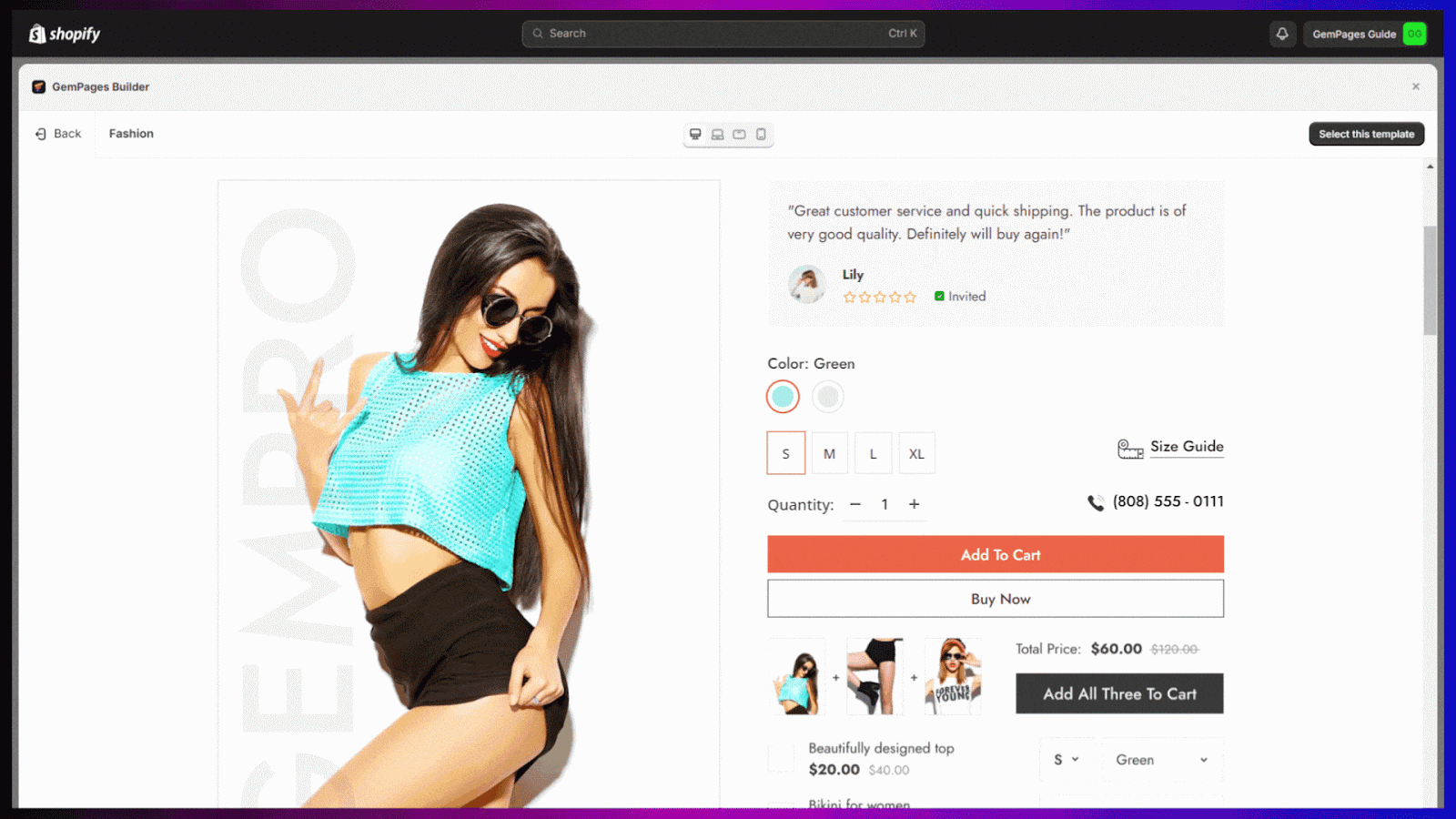
Learn more: How To Use Product Recommendation On Your Shopify Store to Boost Sales
7. Build a Solid eCommerce Tech Stack
An eCommerce tech stack (aka technology stack) is an eCommerce infrastructure built with different software solutions that work together to help the online store perform various functions.
For Shopify merchants, building a great tech stack is very convenient thanks to its giant ecosystem of Shopify apps. Here’s our recommended eCommerce to boost roi formula for online store
- The eCommerce Platform: Shopify
- Website & Landing Page Builder: GemPages
- Automations: Shopify Flow
- Email Marketing: Automizely or Omnisend
- Customer Support: Chatty
- Upselling & Cross-Selling: ReConvert or Selleasy
8. Use Artificial Intelligence the Right Way
Artificial intelligence (AI) has many applications in eCommerce that can help boost ROI if used the right way. Here are some of the use cases:
- AI-based personalization and recommendations to increase sales and revenue
- AI-powered inventory management to reduce inventory cost
- AI-based dynamic pricing to increase profit margins
- AI page builders to create stunning landing pages
- AI-based email marketing solutions to increase sales and revenue
- AI voice commerce to enable customers to use voice commands
9. Observe the Industry & Competitors
The eCommerce market conditions and trends are constantly changing. Always stay on top of industry updates and come up with new ideas and strategies to leverage ongoing trends.
That said, you don’t need to jump on every single trend. Consider what aligns with your brand. Analyze the potential of the opportunities and take action or calculated risks accordingly.
Also, keep an eye on your competitors. Identify what’s working the best for them and what are their weak areas. Can their weakness be your strength? If yes, take the necessary actions and take over your competitors.
10. Build Solid Conversion Funnels
To generate maximum ROI from your marketing, develop a systematic approach through different funnel strategies.
Here’s a brief overview of the funnels that you could build and implement for your eCommerce or Shopify store:
-
Website Conversion Funnel:
A website conversion funnel is the strategic design and structure that takes customers through the journey from being a website visitor to a buyer.
The idea is to design the journey from your website’s homepage to the checkout or thank you page in a way that not only converts leads but also makes them repeat buyers.
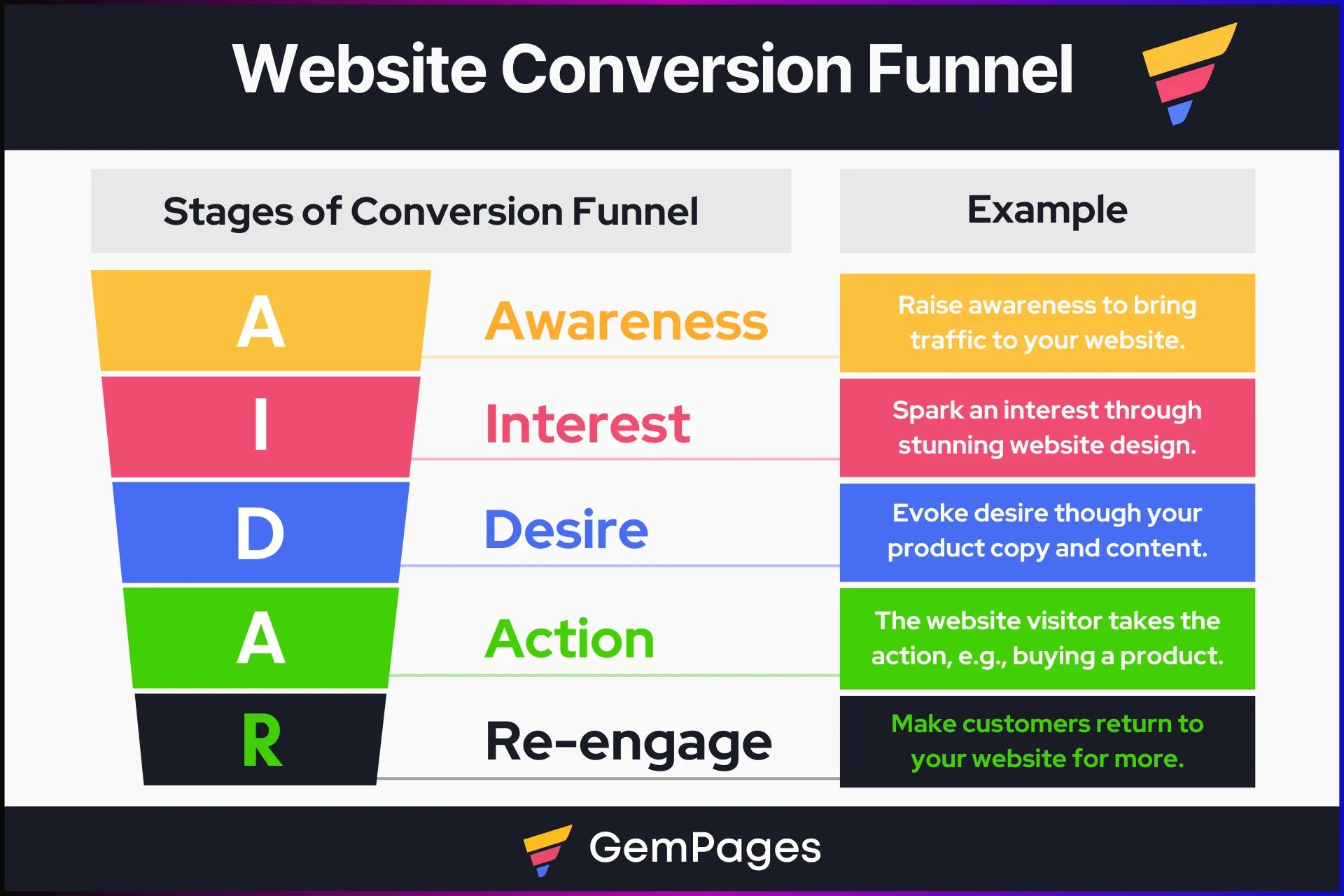
Learn more: How to Create an eCommerce Website Conversion Funnel
-
Sales Funnel:
A sales funnel is a marketing strategy created to walk customers through a journey—consisting of subsequent stages—from making them aware of your product/service to enticing them to buy it.
These stages include awareness, interest, evaluation, desire, sale, and retention. During all these different stages, you need to engage and drive actions through your content and copy.
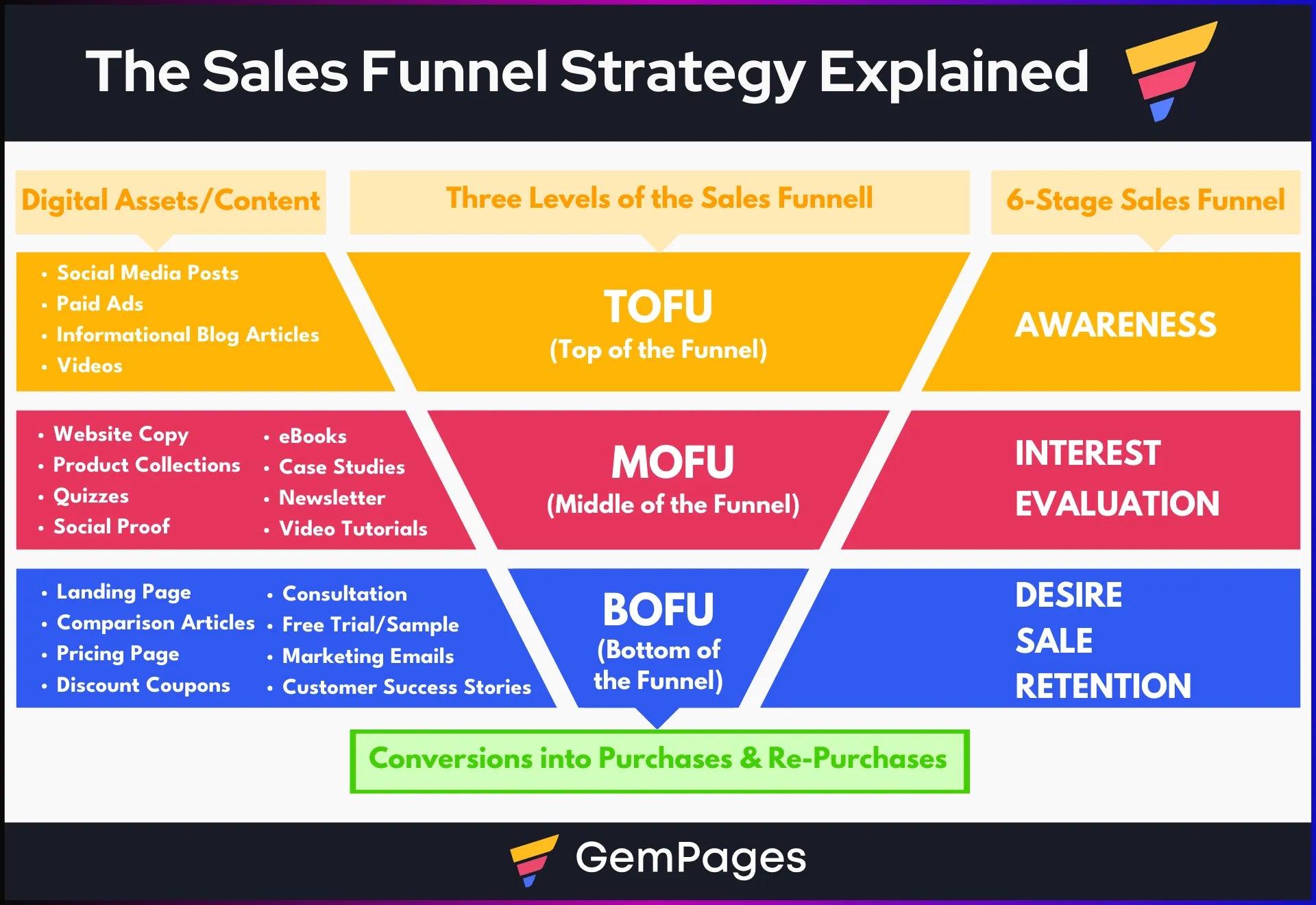
Learn more: How to Build An eCommerce Sales Funnel Strategy
-
Click Funnel:
A click funnel is a digital marketing strategy where you create a series of clickable digital assets—mostly running automated—that lead your customers through a journey from “exploring your initial offer” to “the ultimate conversion event”.
These digital assets include social media posts with links, clickable ads, lead magnets, landing pages, sales pages, emails, etc. So, you can track ROI in marketing campaigns better.
Learn more: A Step-by-Step Guide to Building An Effective Click Funnel
Pro tip: GemPages Sales Funnels can be the ultimate solution to your loss of sleep at night, haunted by revenue and profit issues. This is GemPages latest tool that will empower you - Shopify store owners - to effortlessly craft and fine-tune an exceptional sales journey, ensuring optimal conversion, average order value (AOV) growth, upsell opportunities, and ultimately maximize your Shopify store revenue.

11. Nurture Leads with Email & SMS Marketing
So, we reviewed different funnel strategies. Now, let’s talk about one of the most important aspects of these funnels, i.e., lead nurturing.
All the potential customers who visit your website but don’t make a purchase are still an opportunity for your brand. When you’re spending money on ads to bring these visitors, you can’t afford to lose too many of these opportunities.
To get them into your funnel, you need to have their emails or phone numbers (or both) — of course, with their consent for email and/or SMS marketing.
Then, email marketing helps with the lead nurturing process and helps you bring sales from these leads. Similarly, SMS marketing is useful for quick promotional campaigns.
For example, Absolute Collagen does great at email marketing through its sales funnel. This email from the brand entices customers to check out the limited-time offer and it also has a header section to check out its blog and gifts collection.
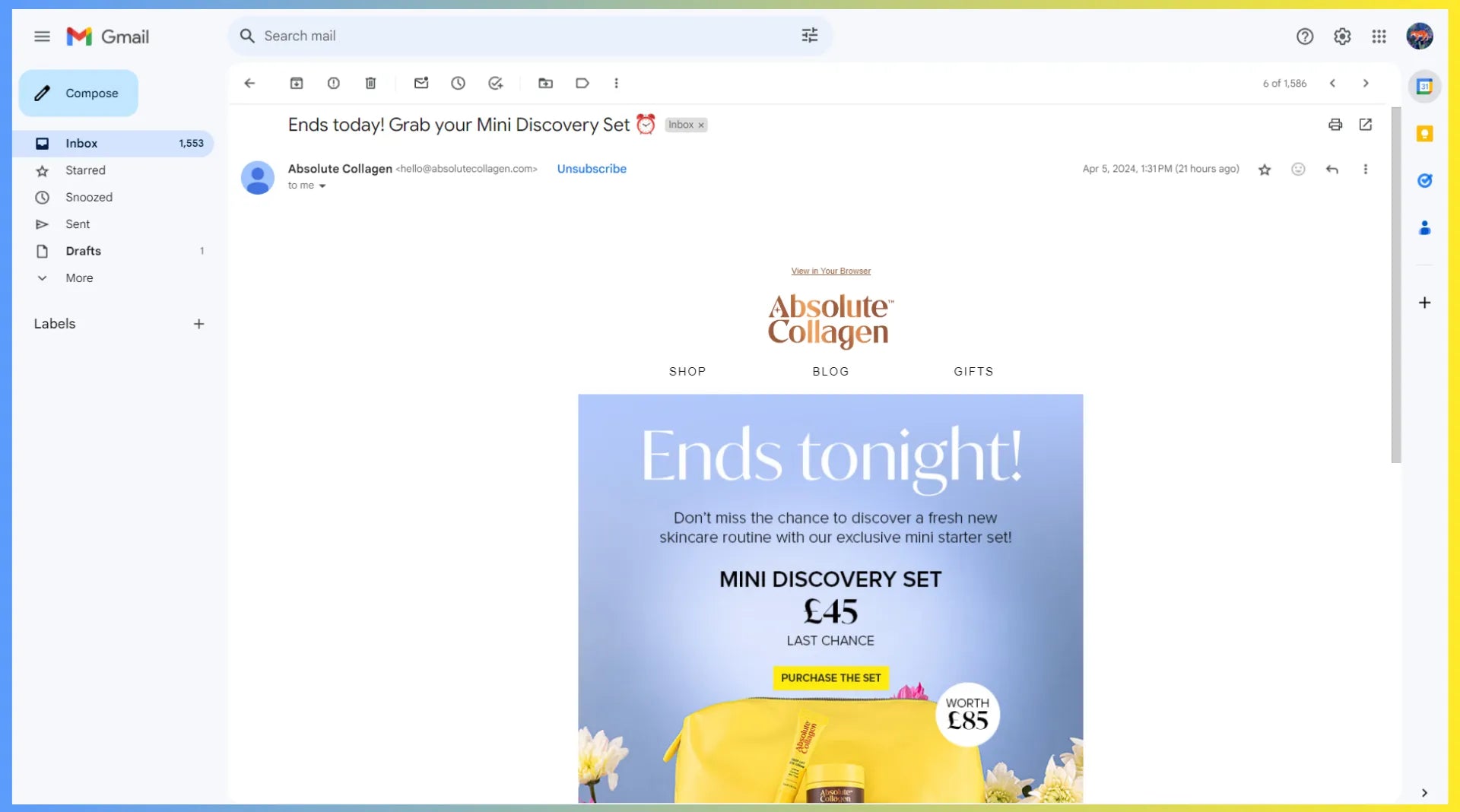
12. Promote Upselling and Cross-Selling Products
Upselling and cross-selling help you increase your average order value (AOV). And the result? An increased ROI.
Imagine you spent $10 on average to bring one sale from 50 customers who visited your store. If that customer is purchasing a $40 product and your profit margin is 20%, you’ll make $8 profit and lose $2 on that sale.
Now, if you upsell an upgraded $80 product to the same customer, with a 20% profit margin, you’ll make a $16 profit. Meaning, that you’ll earn $6 profit on that product instead of a loss (after deducting the ad spend).
This is the power of upselling and cross-selling.
Shopify App Store has many apps that can help you create upselling and cross-selling offers on product, cart, checkout, and even thank you pages. Apps like FoxSell, for instance help merchants create Mix & Match bundle-based upsells, boosting AOV without the need for heavy discounts.
13. Enhance the Customer Experience
Happy customers will not only buy more from your store but will also recommend others to shop from your store. They can massively reduce your customer acquisition cost (CAC), and thus, increase your ROI.
Make sure the customers go through a smooth journey throughout the buying process. Provide them with the necessary information easily. For example, your returns policy and FAQs should be easily accessible to customers.
On top of that, you can also provide a live chat option to customers to resolve their queries on a real-time basis and convert leads into customers. While you can use chatbots for basic queries, nothing beats enabling customers to get human support.
Adored Vintage—a women's clothing brand inspired by vintage fashion—has two different options on its live chat widget: 1. Customers can type their text messages or 2. Choose the tabs given for “Instant answers”.
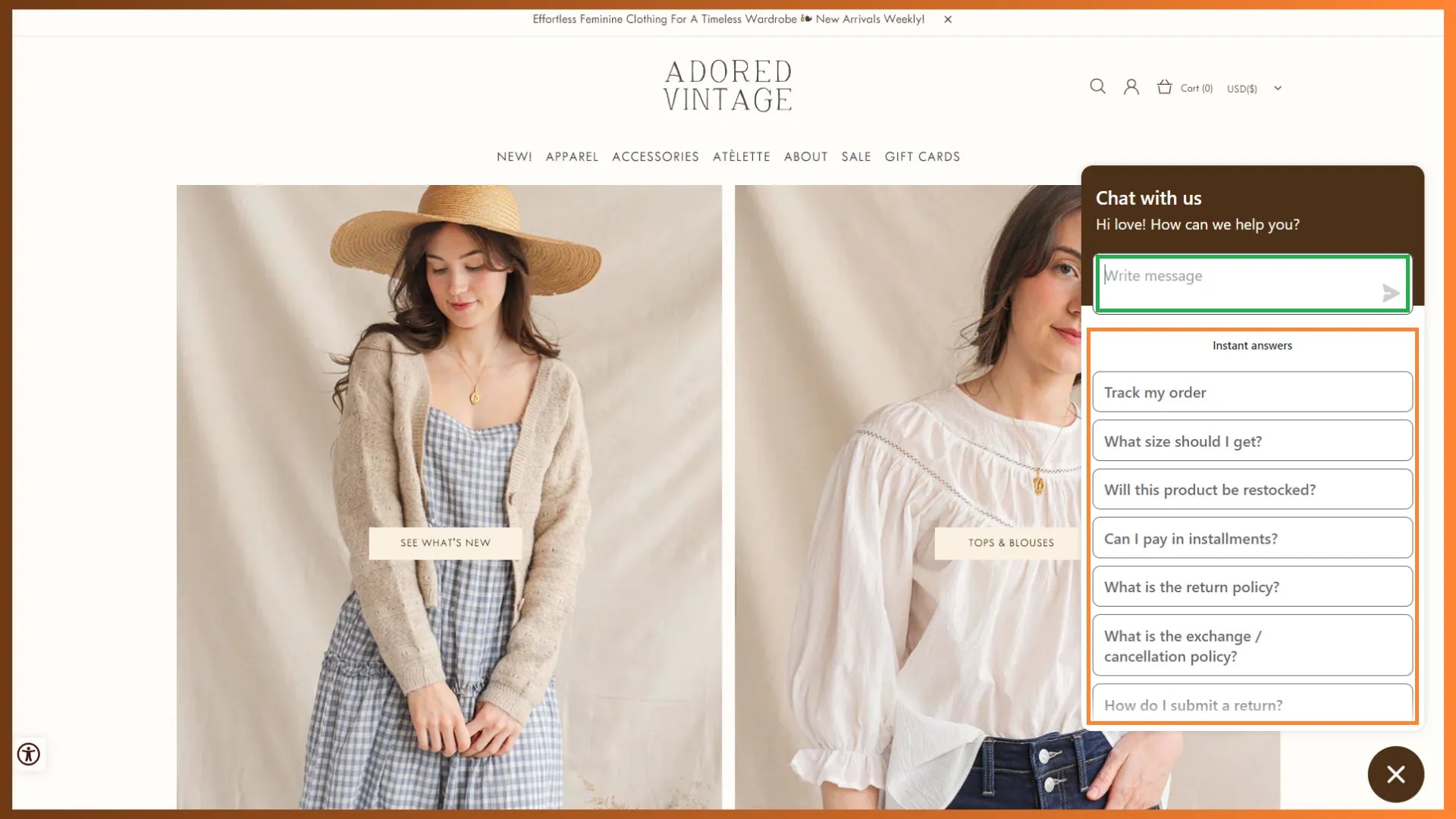
Pro tip: Use a referral program app like Growave or ReferrLy to reward your customers for successful referrals. This will add an extra reason for them to promote your brand and customers will feel rewarded for their efforts. Win-Win for both you and your customers.
14. Win Your Customers’ Trust with Social Proof
In online shopping, it’s imperative that the customers feel secure and comfortable to buy your products. Social proof can help build that trust and credibility of your brand.
We already discussed one of the main social proof elements — customer reviews. But that’s not the only way to build social proof. You can try different methods such as:
- User-generated content (UGC) from social media feeds
- Expert reviews or endorsements
- Awards or recognitions
- Product-wise number of sales
- Press mentions
- Number of customers who purchased from your brand
Pro Tip: You can encourage your customers to leave their genuine reviews by offering them reward points for sharing their honest feedback. To do this, you just need to have a loyalty program app on your Shopify store.
15. Monitor the Metrics Contributing to Your ROI
To improve your ROI, you need to make sure you’re measuring it appropriately and timely. Here are some of the key metrics that you should monitor to identify any areas of improvement:
-
Total Website Traffic
- Organic traffic
- Paid traffic
- Conversion Rate
- Sales by Channel
- Average Order Value (AOV)
- Customer Lifetime Value (CLV)
- Customer Acquisition Cost (CAC)
- Cart Abandonment Rate
- Checkout Abandonment Rate
Most of these data points will be available in your eCommerce dashboard or analytics. However, some of them may need to be calculated manually or with third-party data, such as CLV and CAC.
Challenges in Measuring eCommerce ROI
-
Revenue Attribution to Marketing Channel
If you’re looking to measure the ROI of your different marketing channels, you just need to embrace the fact that the method has some flaws that make it hard to get accurate data.
You may find it difficult to accurately attribute revenue to its primary source or channel. Consider this example:
> A customer visited your blog.
> Read a blog article.
> And subscribed to your newsletter.
> Now, when you run an email marketing campaign, the customer purchases a product from your store.
So, you might attribute this revenue to the “Email Marketing Campaign” whereas the customer actually read your email thanks to your “Blog Content Marketing”.
-
Difference in Time Duration of Investment & Returns
Every ROI calculation is not straightforward. Some investments produce returns in the long run and keep giving your returns for a long time.
So, if you calculate ROI within a year’s timeframe, it might not give you the real picture or future potential. Let’s understand this with an example:
> You invested heavily in SEO for an entire year. (And SEO takes time.)
> It didn’t give you any results for the first year. So, your ROI went down negative (−20%), meaning you incurred a loss instead of a return.
> You continued the efforts the next year, and your website started showing in the top search results.
> Now, there’s a huge boost in your revenue. And thus, your ROI goes up (+30%).
If you had given up on your SEO efforts after seeing −20% ROI in the first year, you would’ve not made 30% ROI the next year. So, you may need to be patient enough to evaluate the effectiveness of campaigns based on the channel.
-
Difficulties in Measuring Customer Lifetime Value (CLV)
If you’re going to use the CLV-based formula to calculate ROI, it has its own challenges as well.
Two important variables that go into the calculation of CLV, i.e., the purchase frequency and the average customer lifespan, can be difficult to measure accurately.
Despite these challenges, ROI is considered to be one of the most popular methods to measure the profitability of marketing campaigns. Mainly because it helps immensely in making crucial business decisions related to investments.
Start Boosting Your eCommerce ROI Now!
So, we’ve shared all the strategies you need to boost your ROI, now it’s time for execution.
By the way, the long list of strategies may sound overwhelming but you don’t have to jump on every single strategy together. Start small and start with the research on your target audience first.
Some of the strategies could be interlinked with each other. For example, funnels and email marketing go hand in hand. Define your strategies with a timeline and then keep improving and scaling.
Join GemPages Facebook community to learn from other entrepreneurs and experts and share your experiences with like-minded people.

FAQs on eCommerce ROI
1. The formula with “net profit” as the key consideration:
ROI = (Net Profit / Investment) × 100%.
2. The formula with “customer lifetime value” as the key consideration:
ROI = (Customer Lifetime Value / Investment) × 100%.



 Facebook Community
Facebook Community Change Log
Change Log Help Center
Help Center












